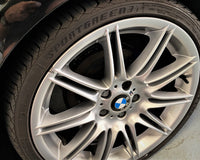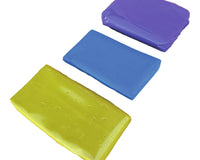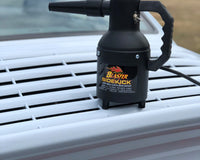Water spots are the stubborn marks left behind after water evaporates from a car’s surface, leaving mineral deposits such as calcium and magnesium. These can appear on paint, glass, and chrome, and if left untreated, they may etch into the surface over time, leading to permanent damage. The severity of water spots depends on the mineral content of the water and how long the spots are left untreated.
Types of Water Spots
Type I: Mineral Deposits
These are the most common, caused by hard water. They usually appear as white or cloudy marks and sit on the surface.
Type II: Etched Spots
When mineral deposits are not removed promptly, they can bake into the surface, especially under sunlight, causing etching.
Type III: Bonded Contaminants
These result from acidic rain or industrial fallout mixed with water and can bond chemically with the surface.
Why Quick Removal is Important
The longer water spots remain on your car, the more they embed into the finish. In worst cases, they can degrade protective coatings or even eat into the clear coat of your paint. Prompt action preserves the appearance and longevity of your vehicle’s surfaces.
What You'll Need
-
Clean microfibre towels
-
pH-neutral car shampoo
-
Distilled white vinegar
-
Detailing clay bar
-
Water spot remover (non-abrasive)
-
Spray bottle
-
Polishing compound (for etched spots)
-
Machine polisher or hand applicator pad
-
Deionised or distilled water for rinsing
Removing Water Spots from Car Paint
Step 1: Wash the Surface Thoroughly
Start by washing your car with a pH-neutral shampoo to remove dirt, dust, and loose contaminants. Always rinse with deionised water to avoid introducing new mineral deposits.
Step 2: Use Vinegar Solution
Mix one part distilled white vinegar with one part deionised water in a spray bottle. Lightly mist the affected area and allow it to sit for 1–2 minutes. The acetic acid in vinegar helps dissolve mineral deposits.
Gently wipe with a microfibre towel. Rinse off with clean water.
Step 3: Apply a Clay Bar
If spots persist, use a clay bar lubricated with detailing spray to lift bonded contaminants from the surface. This is effective for light to moderate spots.
Step 4: Polish for Etched Water Spots
For etched or stubborn marks, use a light polishing compound. Apply it using a foam applicator pad or machine polisher, working in small circular motions. Finish by wiping off residue with a clean towel.
Removing Water Spots from Glass
Step 1: Clean the Glass
Use a dedicated automotive glass cleaner to remove dirt and grime. Dry with a lint-free towel.
Step 2: Use Vinegar or Glass-Safe Spot Remover
Spray a 50/50 vinegar-water mix directly onto the glass. Let it dwell briefly and gently scrub using a microfibre towel.
For tougher spots, use a dedicated water spot remover formulated for glass. Avoid using household cleaners that may damage tinted films.
Step 3: Use Fine Steel Wool (Optional)
0000-grade steel wool, used gently, can remove persistent water marks without scratching auto glass. Always test in a corner first.
Step 4: Final Wipe and Seal
Wipe down the glass with a fresh towel and apply a glass sealant or rain repellent for protection.

Removing Water Spots from Chrome
Step 1: Gentle Clean
Wash chrome areas with mild shampoo and water. Rinse and dry completely to assess the severity of the spotting.
Step 2: Vinegar Soak or Paste
Soak a microfibre towel in vinegar solution and lay it over the affected chrome for 2–3 minutes. This softens mineral buildup.
You may also use a baking soda paste (baking soda and water) applied with a soft cloth to lightly buff the surface.
Step 3: Polish Chrome
Use a chrome polish to restore the shine and remove any remaining residue. Apply in circular motions and buff with a clean cloth.
Step 4: Seal with Protectant
Once clean, apply a sealant or wax specifically safe for chrome. This adds a barrier against future spots.
How to Prevent Water Spots in the Future
-
Use filtered or deionised water when washing your car.
-
Dry your vehicle immediately using a microfibre drying towel.
-
Apply a ceramic coating or wax to create a hydrophobic layer.
-
Wash your car in the shade, especially during hot weather.
-
Use a blower to remove water from crevices and trims.
Final Thoughts
Water spots are a common but preventable issue in car maintenance. Understanding their origin and how to treat them across different surfaces—paint, glass, and chrome—can save you from long-term cosmetic damage. By using safe, proven methods and adopting preventative measures, you’ll keep your vehicle looking immaculate and spot-free for longer.




